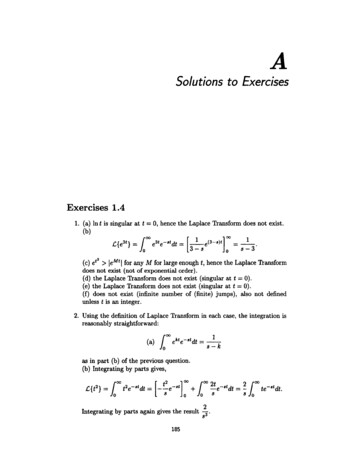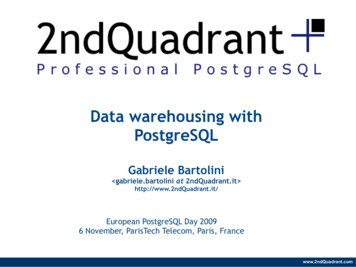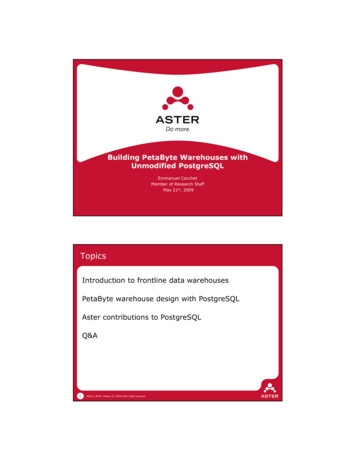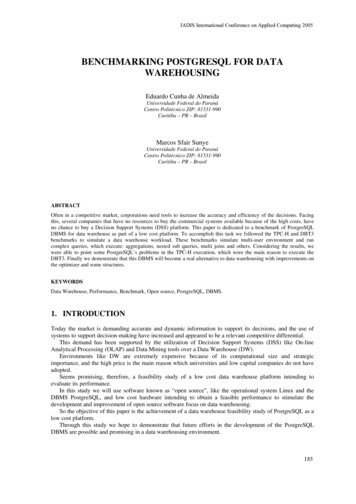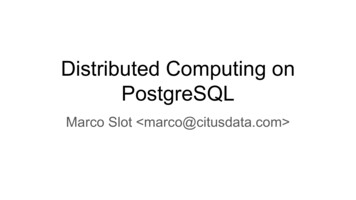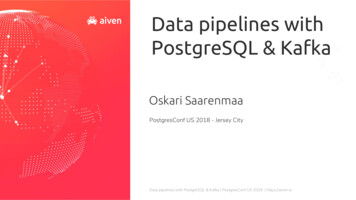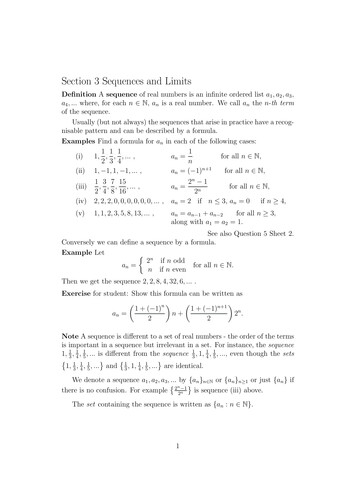
Transcription
APPENDIX A PostgreSQL Database LimitsWhen we use a database to store information, we are tempted to ignore the fact that on noplatform do we have the luxury of infinite storage. All database systems are limited in someway, and PostgreSQL is no exception. The amount of data that can be stored in a single column,the maximum number of columns allowed in a table, and the total size of any table all havelimits, albeit quite large ones.As a limit is approached, the performance of the database will degrade. If we are, for example,manipulating very large fields consuming a large fraction of available (virtual) memory, it islikely that performance will begin to be unacceptable. Finally, PostgreSQL will be physicallyunable to perform an update.Recent releases of PostgreSQL have seen most database limits relaxed, and in many cases,effectively removed. In this appendix, we will mention some of the restrictions that remain asof PostgreSQL version 8.0. For updates on limits for later versions, check out the PostgreSQLweb site at http://www.postgresql.org. Note The information here is derived from the PostgreSQL FAQ and mailing list contributions made byPostgreSQL developers.Where a size is given as “No Limit,” this means that PostgreSQL alone imposes no limit.The maximum size will be determined by other factors, such as operating system limits and theamount of available disk space or virtual memory. The network transport may also imposelimits. For example, there are typically limits on the size of a query that can be made via ODBC,depending on the driver. Memory limits may prevent very large columns, rows, or result setsfrom being created, transferred across a network (which in itself will be slow), or received bythe client.Database Size: No LimitPostgreSQL does not impose a limit on the total size of a database. Databases of 4 terabytes(TB) are reported to exist. A database of this size is more than sufficient for all but the mostdemanding applications.543
544APPENDIX A POSTGRESQL DATABASE LIMITSDue to the way that PostgreSQL arranges its data storage, you may see some performancedegradation associated with databases containing many tables. PostgreSQL may use a largenumber of files for storing the table data, and performance may suffer if the operating systemdoes not cope well with many files in a single directory. The introduction of tablespaces inPostgreSQL 8.0 helps the database administrator to minimize these effects. Tablespaces arecovered in Chapter 11.Table Size: 16TB–64TBPostgreSQL normally stores its table data in chunks of 8KB. The number of these blocks islimited to a 32-bit signed integer (just over two billion), giving a maximum table size of 16TB.The basic block size can be increased when PostgreSQL is built, up to a maximum of 32KB,thereby giving a theoretical table size limit of 64TB.Some operating systems impose a file size limit that prevent files of this size from beingcreated, so PostgreSQL stores table data in multiple files, each 1GB in size. For large tables, thiswill result in many files and potential operating system performance degradation, as notedearlier.Rows in a Table: No LimitPostgreSQL does not impose a limit on the number of rows in any table.Table Indexes: No LimitThere is no PostgreSQL-imposed limit on the number of indexes you can create on a table.Of course, performance may degrade if you choose to create more and more indexes on a tablewith more and more columns.Field Size: 1GBPostgreSQL has a limit of 1GB for the size of any one field in a table. In practice, the limit comesfrom the amount of memory available for the server to manipulate the data and transfer it tothe client.Columns in a Table: 250 The maximum number of columns that can be accommodated in a PostgreSQL table dependson the configured block size and the type of the column. For the default block size of 8KB, atleast 250 columns can be stored. This can rise to 1,600 columns if all of the columns are verysimple fields, such as integer values. Increasing the block size increases these limits accordingly.Row Size: No LimitThere is no explicit maximum size of a row. But, of course, the size of columns and theirnumber are limited as described in the preceding text.
APPENDIX B PostgreSQL Data TypesPostgreSQL has a particularly rich set of data types, which are described in Chapter 11 of thisbook, as well as in Chapter 8 of the PostgreSQL documentation.In this appendix, we list the more useful types, ignoring some of the very specialized typesand those types used only internally by PostgreSQL. Use \dT (or \dT for even more detail) frompsql for a definitive list of types.In the tables in this appendix, the standard SQL name appears first, which PostgreSQLgenerally accepts, followed by any PostgreSQL-specific alternative names. Some types arespecific to PostgreSQL and in such cases, no SQL standard name is given in the tables.As long as it’s practical, we suggest that you stick to the standard SQL types and names.Some of the official SQL names are almost invariably shortened in real use; for example int forinteger, bool for boolean, and varchar for character varying. We have adhered to the commonconvention of using the shorter name in this book.Logical TypesTable B-1 shows the PostgreSQL logical data type: boolean. Note that boolean was not officiallyadded to the SQL language until the SQL99 standard, although it was in common use longbefore that.Table B-1. PostgreSQL Logical Data TypeSQL NamePostgreSQL Alternative NameNotesbooleanboolHolds a truth value. Will accept values such asTRUE, 't', 'true', 'y', 'yes', and '1' as true.Uses 1 byte of storage, and can store NULL,unlike a few proprietary databases.545
546APPENDIX B POSTGRESQL DATA TYPESExact Number TypesTable B-2 shows the PostgreSQL exact number data types.Table B-2. postgresql Exact Number TypesSQL NamePostgreSQLAlternative NameNotessmallintint2A signed 2-byte integer that can store–32768 to 32767.integer, intint4A signed 4-byte integer that can store–2147483648 to 2147483647.bigintint8A signed 8-byte integer, givingapproximately 18 digits of precision.bitbitStores a single bit, 0 or 1. To insertinto a table, use syntax such asINSERT INTO VALUES(B'1');.bit varyingvarbit(n)Stores a string of bits. To insert into atable, use syntax such as INSERT INTO VALUES(B'011101'); .Approximate Number TypesTable B-3 shows the PostgreSQL approximate number data types. Note that the decimal type isjust an alias for numeric, which is the term used by the SQL standard and generally preferred.Similarly, rather than float, use real or double precision.Table B-3. PostgreSQL Approximate Number TypesSQL NamePostgreSQLAlternative NameNotesStores an exact number to theprecision specified. The user guidestates there is no limit to the precisionthat may be specified.numeric (precision, scale)realfloat4A 4-byte, single-precision,floating-point number.double precisionfloat8An 8-byte, double-precision,floating-point number.moneyEquivalent to numeric(9,2), storing 4bytes of data. Its use is discouraged,as it is deprecated and support maybe dropped in the future.
APPENDIX B POSTGRESQL DATA TYPES547Temporal TypesTable B-4 shows the PostgreSQL data types for date and time.Table B-4. PostgreSQL Types for Date and TimeSQL NamePostgreSQLAlternative NameNotestimestampdatetimeStores dates and times from 4713 BC to 1465001 AD, with a resolution of 1 microsecond. You may also see timestamptz usedsometimes in PostgreSQL, which is a shorthand for timestampwith time zone.intervalintervalStores an interval of approximately /– 178,000,000 years,with a resolution of 1 microsecond.datedateStores dates from 4713 BC to 32767 AD, with a resolutionof 1 day.timetimeStores a time of day, from 0 to 23:59:59.99, with a resolutionof 1 microsecond.Character TypesTable B-5 shows the PostgreSQL character data types.Table B-5. PostgreSQL Character TypesSQL NamePostgreSQLAlternative NameNoteschar, characterbpcharStores a single character.char(n)bpchar(n)Stores exactly n characters, which will be padded withblanks if fewer characters are actually stored.character varying(n)varchar(n)Stores a variable number of characters, up to amaximum of n characters, which are not paddedwith blanks. This is the standard choice for characterstrings.textA PostgreSQL-specific variant of varchar, which doesnot require you to specify an upper limit on the numberof characters.
548APPENDIX B POSTGRESQL DATA TYPESGeometric TypesTable B-6 shows the PostgreSQL geometric data types. These are specific to PostgreSQL, sothere are no SQL names listed.Table B-6. PostgreSQL Geometric TypesPostgreSQL NameNotespointAn x,y valuelineA line (pt1, pt2)lsegA line segment (pt1, pt2)boxA box specified by a pair of pointspathA sequence of points, which may be closed or openpolygonA sequence of points, effectively a closed pathcircleA point and a length, which specify a circleMiscellaneous PostgreSQL TypesAs shown in Table B-7, PostgreSQL has some other data types, which do not fit into the previouscategories. SQL names are not applicable to these types.Note that PostgreSQL does not implement the serial type as a separate type, although itaccepts the conventional SQL syntax. Internally PostgreSQL uses an integer to store the valueand a sequence to manage the automatic incrementing of the value. When a table is createdwith a serial type, an implicit sequence (named using an underscore separated combinationof the table name, the column name, and seq) is created to manage the serial data column.This implicit sequence will be dropped automatically if the table is dropped.The cidr type refers to Classless Inter-Domain Routing (CIDR). This is a newer standardfor IP addressing. This is in contrast to the original form of IP address assignment, which usesthree classes—A, B, and C—that have a network part of 8, 16, and 24 bits, respectively, allowing16.7 million, 65 thousand, and 254 hosts per network, respectively. CIDR allows network masksof any size, so you can better allocate IP addresses and route between them in a hierarchicalfashion.
APPENDIX B POSTGRESQL DATA TYPESTable B-7. Other PostgreSQL TypesPostgreSQL NameNotesserialIn conventional SQL usage, a serial (or auto-incrementing integer) isa numeric column in a table that increases each time a row is added.oidAn object identifier. Internally, PostgreSQL adds, by default, a hiddenoid to each row, and stores a 4-byte integer, giving a maximum value ofapproximately 4 billion. This type is also used as a reference whenstoring binary large objects. We recommend you do not use this typeor rely on its existence.cidrStores a network address of the form x.x.x.x/y where y is the netmask.inetSimilar to cidr, except the host part can be 0.macaddrA MAC address of the form XX:XX:XX:XX:XX:XX.549
APPENDIX C PostgreSQL SQL SyntaxReferenceThis appendix presents a list of the PostgreSQL commands, followed by the syntax for each ofthese commands. This set of commands is taken from the psql command-line tool. Using psql,you can generate the complete list of commands by using the \help command. For the syntaxof a specific command, use \help command .More detailed explanations are available in Part VI (Reference), Section I (SQL Commands)of the PostgreSQL manual.PostgreSQL SQL CommandsABORTCREATE INDEXDROP TYPEALTER AGGREGATECREATE LANGUAGEDROP USERALTER CONVERSIONCREATE OPERATOR CLASSDROP VIEWALTER DATABASECREATE OPERATORENDALTER DOMAINCREATE RULEEXECUTEALTER FUNCTIONCREATE SCHEMAEXPLAINALTER GROUPCREATE SEQUENCEFETCHALTER INDEXCREATE TABLEGRANTALTER LANGUAGECREATE TABLE ASINSERTALTER OPERATOR CLASSCREATE TABLESPACELISTENALTER OPERATORCREATE TRIGGERLOADALTER SCHEMACREATE TYPELOCKALTER SEQUENCECREATE USERMOVEALTER TABLECREATE VIEWNOTIFYALTER TABLESPACEDEALLOCATEPREPAREALTER TRIGGERDECLAREREINDEX551
552APPENDIX C POSTGRESQL SQL SYNTAX REFERENCEALTER TYPEDELETERELEASE SAVEPOINTALTER USERDROP AGGREGATERESETANALYZEDROP CASTREVOKEBEGINDROP CONVERSIONROLLBACKCHECKPOINTDROP DATABASEROLLBACK TO SAVEPOINTCLOSEDROP DOMAINSAVEPOINTCLUSTERDROP FUNCTIONSELECTCOMMENTDROP GROUPSELECT INTOCOMMITDROP INDEXSETCOPYDROP LANGUAGESET CONSTRAINTSCREATE AGGREGATEDROP OPERATORSET SESSION AUTHORIZATIONCREATE CASTDROP OPERATOR CLASSSET TRANSACTIONCREATE CONSTRAINT TRIGGERDROP RULESHOWCREATE CONVERSIONDROP SCHEMASTART TRANSACTIONCREATE DATABASEDROP SEQUENCETRUNCATECREATE DOMAINDROP TABLEUNLISTENCREATE FUNCTIONDROP TABLESPACEUPDATECREATE GROUPDROP TRIGGERVACUUMPostgreSQL SQL SyntaxABORTAbort the current transaction.ABORT [ WORK TRANSACTION ]ALTER AGGREGATEChange the definition of an aggregate function.ALTER AGGREGATE name ( type ) RENAME TO new nameALTER AGGREGATE name ( type ) OWNER TO new ownerALTER CONVERSIONChange the definition of a conversion.ALTER CONVERSION name RENAME TO new nameALTER CONVERSION name OWNER TO new owner
APPENDIX C POSTGRESQL SQL SYNTAX REFERENCEALTER DATABASEChange a ASEDATABASEnamenamenamenameSET parameter { TO } { value DEFAULT }RESET parameterRENAME TO new nameOWNER TO new ownerALTER DOMAINChange the definition of a domain.ALTER DOMAIN name{ SET DEFAULT expression DROP DEFAULT }ALTER DOMAIN name{ SET DROP } NOT NULLALTER DOMAIN nameADD domain constraintALTER DOMAIN nameDROP CONSTRAINT constraint name [ RESTRICT CASCADE ]ALTER DOMAIN nameOWNER TO new ownerALTER FUNCTIONChange the definition of a function.ALTER FUNCTION name ( [ type [, .] ] ) RENAME TO new nameALTER FUNCTION name ( [ type [, .] ] ) OWNER TO new ownerALTER GROUPChange a user group.ALTER GROUP groupname ADD USER username [, . ]ALTER GROUP groupname DROP USER username [, . ]ALTER GROUP groupname RENAME TO new nameALTER INDEXChange the definition of an index.ALTER INDEX nameaction [, . ]ALTER INDEX nameRENAME TO new nameWhere action is one of:OWNER TO new ownerSET TABLESPACE indexspace name553
554APPENDIX C POSTGRESQL SQL SYNTAX REFERENCEALTER LANGUAGEChange the definition of a procedural language.ALTER LANGUAGE name RENAME TO new nameALTER OPERATORChange the definition of an operator.ALTER OPERATOR name ( { lefttype NONE } , { righttype NONE } )OWNER TO new ownerALTER OPERATOR CLASSChange the definition of an operator class.ALTER OPERATOR CLASS name USING index method RENAME TO new nameALTER OPERATOR CLASS name USING index method OWNER TO new ownerALTER SCHEMAChange the definition of a schema.ALTER SCHEMA name RENAME TO new nameALTER SCHEMA name OWNER TO new ownerALTER SEQUENCEChange the definition of a sequence generator.ALTER[[[SEQUENCE name [ INCREMENT [ BY ] increment ]MINVALUE minvalue NO MINVALUE ]MAXVALUE maxvalue NO MAXVALUE ]RESTART [ WITH ] start ] [ CACHE cache ] [ [ NO ] CYCLE ]ALTER TABLEChange the definition of a table.ALTER TABLE [ ONLY ] name [ * ]action [, . ]ALTER TABLE [ ONLY ] name [ * ]RENAME [ COLUMN ] column TO new columnALTER TABLE nameRENAME TO new name
APPENDIX C POSTGRESQL SQL SYNTAX REFERENCEWhere action is one of:ADD [ COLUMN ] column type [ column constraint [ . ] ]DROP [ COLUMN ] column [ RESTRICT CASCADE ]ALTER [ COLUMN ] column TYPE type [ USING expression ]ALTER [ COLUMN ] column SET DEFAULT expressionALTER [ COLUMN ] column DROP DEFAULTALTER [ COLUMN ] column { SET DROP } NOT NULLALTER [ COLUMN ] column SET STATISTICS integerALTER [ COLUMN ] column SET STORAGE { PLAIN EXTERNAL EXTENDED MAIN }ADD table constraintDROP CONSTRAINT constraint name [ RESTRICT CASCADE ]CLUSTER ON index nameSET WITHOUT CLUSTERSET WITHOUT OIDSOWNER TO new ownerSET TABLESPACE tablespace nameALTER TABLESPACEChange the definition of a tablespace.ALTER TABLESPACE name RENAME TO new nameALTER TABLESPACE name OWNER TO new ownerALTER TRIGGERChange the definition of a trigger.ALTER TRIGGER name ON table RENAME TO new nameALTER TYPEChange the definition of a type.ALTER TYPE name OWNER TO new ownerALTER USERChange a database user menamename[ [ WITH ] option [ . ] ]RENAME TO new nameSET parameter { TO } { value DEFAULT }RESET parameterWhere option can be:[ ENCRYPTED UNENCRYPTED ] PASSWORD 'password'CREATEDB NOCREATEDBCREATEUSER NOCREATEUSERVALID UNTIL 'abstime'555
556APPENDIX C POSTGRESQL SQL SYNTAX REFERENCEANALYZECollect statistics about a database.ANALYZE [ VERBOSE ] [ table [ (column [, .] ) ] ]BEGINStart a transaction block.BEGIN [ WORK TRANSACTION ] [ transaction mode [, .] ]Where transaction mode is one of:ISOLATION LEVEL { SERIALIZABLE REPEATABLE READ READ COMMITTED READ UNCOMMITTED }READ WRITE READ ONLYCHECKPOINTForce a transaction log checkpoint.CHECKPOINTCLOSEClose a cursor.CLOSE nameCLUSTERCluster a table according to an index.CLUSTER index name ON table nameCLUSTER table nameCLUSTERCOMMENTDefine or change the comment of an object.COMMENT ON{TABLE object name COLUMN table name.column name AGGREGATE agg name (agg type) CAST (source type AS target type) CONSTRAINT constraint name ON table name CONVERSION object name DATABASE object name DOMAIN object name FUNCTION func name (arg1 type, arg2 type, .)
APPENDIX C POSTGRESQL SQL SYNTAX REFERENCEINDEX object name LARGE OBJECT large object oid OPERATOR op (left operand type, right operand type) OPERATOR CLASS object name USING index method [ PROCEDURAL ] LANGUAGE object name RULE rule name ON table name SCHEMA object name SEQUENCE object name TRIGGER trigger name ON table name TYPE object name VIEW object name} IS 'text'COMMITCommit the current transaction.COMMIT [ WORK TRANSACTION ]COPYCopy data between a file and a table.COPY table name [ ( column [, .] ) ]FROM { 'filename' STDIN }[ [ WITH ][ BINARY ][ OIDS ][ DELIMITER [ AS ] 'delimiter' ][ NULL [ AS ] 'null string' ][ CSV [ QUOTE [ AS ] 'quote' ][ ESCAPE [ AS ] 'escape' ][ FORCE NOT NULL column [, .] ]COPY table name [ ( column [, .] ) ]TO { 'filename' STDOUT }[ [ WITH ][ BINARY ][ OIDS ][ DELIMITER [ AS ] 'delimiter' ][ NULL [ AS ] 'null string' ][ CSV [ QUOTE [ AS ] 'quote' ][ ESCAPE [ AS ] 'escape' ][ FORCE QUOTE column [, .] ]557
558APPENDIX C POSTGRESQL SQL SYNTAX REFERENCECREATE AGGREGATEDefine a new aggregate function.CREATE AGGREGATE name (BASETYPE input data type,SFUNC sfunc,STYPE state data type[ , FINALFUNC ffunc ][ , INITCOND initial condition ])CREATE CASTDefine a new cast.CREATE CAST (source type AS target type)WITH FUNCTION func name (arg types)[ AS ASSIGNMENT AS IMPLICIT ]CREATE CAST (source type AS target type)WITHOUT FUNCTION[ AS ASSIGNMENT AS IMPLICIT ]CREATE CONSTRAINT TRIGGERDefine a new constraint trigger.CREATE CONSTRAINT TRIGGER nameAFTER events ONtable name constraint attributesFOR EACH ROW EXECUTE PROCEDURE func name ( args )CREATE CONVERSIONDefine a new conversion.CREATE [DEFAULT] CONVERSION nameFOR source encoding TO dest encoding FROM func nameCREATE DATABASECreate a new database.CREATE DATABASE name[ [ WITH ] [ OWNER [ ] db owner ][ TEMPLATE [ ] template ][ ENCODING [ ] encoding ][ TABLESPACE [ ] tablespace ] ]
APPENDIX C POSTGRESQL SQL SYNTAX REFERENCECREATE DOMAINDefine a new domain.CREATE DOMAIN name [AS] data type[ DEFAULT expression ][ constraint [ . ] ]Where constraint is:[ CONSTRAINT constraint name ]{ NOT NULL NULL CHECK (expression) }CREATE FUNCTIONDefine a new function.CREATE [ OR REPLACE ] FUNCTION name ( [ [ arg name ] arg type [, .] ] )RETURNS ret type{ LANGUAGE lang name IMMUTABLE STABLE VOLATILE CALLED ON NULL INPUT RETURNS NULL ON NULL INPUT STRICT [ EXTERNAL ] SECURITY INVOKER [ EXTERNAL ] SECURITY DEFINER AS 'definition' AS 'obj file', 'link symbol'} .[ WITH ( attribute [, .] ) ]CREATE GROUPDefine a new user group.CREATE GROUP name [ [ WITH ] option [ . ] ]Where option can be:SYSID gid USER username [, .]CREATE INDEXDefine a new index.CREATE [ UNIQUE ] INDEX name ON table [ USING method ]( { column ( expression ) } [ opclass ] [, .] )[ TABLESPACE tablespace ][ WHERE
the client. Columns in a Table: 250 The maximum number of columns that can be accommodated in a PostgreSQL table depends on the configured block size and the type of the column. For the default block size of 8KB, at least 250 columns can be stored. This can rise to 1,600 columns if all of th

